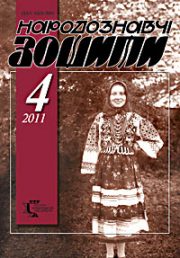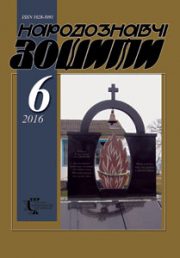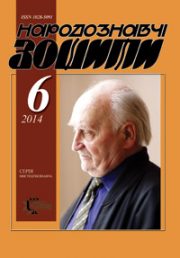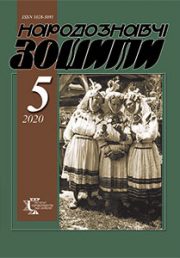The Ethnology Notebooks. 2020. № 2 (152), 410—419
UDK 572.9
DOI https://doi.org/10.15407/nz2020.02.410
COUNT SEMANTICS OF PRIMUM PAR IN MYTHOLOGICAL REPRESENTATIONS OF THE SLAVS
TEMCHENKO Andriy
ORCID ID: http://orcid.org/0000-0003-3999-9459
Ph.D in History, Associate Professor
Associate Professor of History of Ukraine Department,
Bohdan Khmelnytsky National University of Cherkasy
Shevchenko boulevard, 81, Cherkasy, 18000, Ukraine
Contacts: e-mail: temchen@ukr.net
Abstract. Introduction. The relevance of this topic is due to factors related to the philosophical understanding of the process of counting, including the numerical pair «primum par».
The aim of the paper is to consider the Semantics of the «first couple» in the mythological texts and rites of the Slavs.
Methods. The study uses methods of structural anthropology, where the cultural text is seen as a system of semantic balances and counterbalances.
Results. The relevant principles explain the mythological significance of «even-odd», «one-two», «Sunday-Monday» pairs. In particular, primumpar «even-odd» is a local manifestation of the binary concepts associated with the idea of extending life, mating and being born with the opposite «not clear» values that correspond to the state of failure and decline.
The numerical manifestation of the first pair that almases a wide range of meanings is the phraseology «one-two», which is used to encode the informative streams related to the descriptions of the completed action, permanently the effect or statement of the fact. The feasibility of this encoding is attributed to the wording of the number. In particular, in the process of transforming the descriptive values into a specific number of broadcast mythological meanings occurs compactly and quickly. Perception of the information is ensured by the fact that addressee has a decoding tool, resulting in primumpar unfolds in the descriptive text.
The semantic tone of the couple «one-two» is provided by the first component of phraseology, statement of primacy and strength, the next part of which creates precedent plot, implementing in time and space the potential of the «first». In this case, the pair «one-two» is a brief description of a certain cycle, outlined by the two boundary points — by birth and dying. Instead of the unambiguous nominatives of the lexical couple «one-two» allows to «reload» the system, which describes the inappropriate state of mythological picture of the world, which involves washing the old (unbalanced, sick, unsuitable to Life) and the birth of another (synchronized, healthy, rejuvenated) structure. The semantic equivalent of the «one-two» sequence is the timeline pair «Sunday-Monday», where Sunday is associated with the concept of «first», and Monday is identified with the «second». In this context, the «first» semantics is much deeper because it transcends numerical symbolism. In a mythological etiology, Sunday is the creation of the day, that’s why he almases all possible semantic levels (astronomical, bodily, time, spatial, artistic), related to birth and life.
Keywords: mythological picture of the world, number, time, Sunday/Monday, one/two, even/odd, birth/dying, ritual text, divination, semantics, taboo.
Received 17.03.2020
REFERENCES
Toporov, V.N. (2004). Nostratics, glossogenetics, etymology of philosophers and poets. Toporov V.N. Research on etymology and semantics (Vol. I). Theory and some its private applications. Moscow: Slavic Culture Languages [in Russian].
Toporov, V.N. Number and text. Retrieved from https://www.gumer.info/bibliotek_Buks/Linguist/topor/chisl_text.php (Date of appeal: 26.10.2019) [in Russian].
Toporov, V.N. (2005). Numeric code in spells (Based on the materials of the collection of L.N. Maykov «Great Russian spells). Spell text. Genesis and structure (Р. 194—246). Moscow: Indrik [in Russian].
Valentsova, M.M. (2002). The first in the Slavic traditional culture. Indicative space of the culture (Р. 192—208). Moscow: Indrik [in Russian].
Sedakova, I.A. (2002). Semantics and symbolism of the second among the Bulgarians (with some Slavic parallels). Indicative space of the culture (Р. 209—224). Moscow: Indrik [in Russian].
Bessonov, I.A. Numerical modelling systems in mythological and ritual practices, folklore and literary texts. Retrieved from: http://www.ruthenia.ru/folklore/folklorelaboratory/Bessonov04.htm (Date of appeal 26.10.2019) [in Russian].
Fasmer, M. (1986). The etymological dictionary of the Russian language: in 4 v. (Vol. 2 (Е—Муж). Moscow: Progress [in Russian].
Efremova, T.F. (2000). New Dictionary of the Russian Language. Interpretive: 2 t. Moscow: the Russian Language (Vol. 1: (А—О); Vol. 2: (П—Я). Retrieved from: http://slovonline.ru/slovar_efremova/ ( Date of appeal 26.10.2019) [in Russian].
Chubynsky, P.P. (1995). Wisdom of the Centuries. Ukrainian folklore in Pavlo Chubynsky’s creative heritage: in 2 v. (Vol. 1). Kyiv: Art [in Ukrainian].
Usov, V.N. (2012). On the specifics of philosophical reflection. Herald of South Ural State University 10 (269). Series «Social and Humanities» (Issue 18, pp. 195—199) [in Russian].
Potebnya, A.A. (1989). On some symbols in Slavic folk poetry. In Potebnya A.A. The Word and the Myth (Pp. 285—378). Moscow: Pravda Publishing House [in Russian].
Temchenko, A. (2015). Traditional mantic practices: archaic character of the symbolic system. Cherkasy: Intraliga TOR [in Ukrainian].
Agapkina, T.A., Levkiyevskaya, E.E., & Toporkov, A.L. (Eds.). (2003). Polesye conspiracies (in the records of 1970—1990-ies). Moscow: Indrik [in Russian].
Claude Levi-Strauss Myth and Meaning. London and NewYork (P. 11). Retrieved from: http://historiaocharkeologi.com/kanada/myth_and_meaning.pdf (Date of appeal 26.10.2019).
Temchenko, A. (2014). Semantics of counting: The concept of «first» in the mythological representations of Ukrainians (on the material of charms). Visnyk of Cherkassy University. «Historical Sciences» series, 29 (322), 29—33. Cherkasy [in Ukrainian].
Fasmer, M. (1987). The etymological dictionary of the Russian language: in 4 v. (Vol. 3). Moscow: Progress [in Russian].
Krysin, L.P. (1984). The interpretive-combinatory dictionary of the Russian language. Experiences of semantic-syntactical description of Russian vocabulary. Wiener Slawistischer Almanach. Sonderbend 14 (Pp. 700—716). Wien [in Russian].
Yermolenko, S. For one time you would not tell about one! Retrieved from: http://kulturamovy.univ.kiev.ua/KM/pdfs/mix/61-12-65-26.pdf (Date of appeal 09.11.2019) [in Ukrainian].
Sreznevsky, I.I. (Ed.). (1993). Materials for the Dictionary of the Old Russian language on written monuments. Edition of the Department of the Russian Language and Literature of the Imperial Academy of Sciences: in 3 v. (Vol. 1). St. Petersburg: Printing House of the Imperial Academy of Sciences, 1893—1903 [in Russian].
Storozhenko, N.V. (1892). «Malorussian superstitions, which few who believed, collected in 1776» (the manuscript of A.I. Chepa). Kiev’s old days (Vol. ХХХVІ, b. 1, pp. 119—130) [in Russian].
Nesterovsky, P. (1905). Materials on the ethnography of the Bessarabian Rusins. Kiev’s old days (Vol. ХСІ, pp. 73—125) [in Russian].
Ukrainian deputy. (1993). Kyiv: Dnipro [in Ukrainian].
Talanchuk, O.M. (Ed.). (1992). Recipes of folk medicine, ordering from illness. Ukrainian charm (Рp. 32—95). Kyiv: Lybid [in Ukrainian].
Korniyenko, G. (1991). Ordering. Pedigree, 2, 8—13 [in Ukrainian].
Secret power of words (charms, spells), 2. (1992). Kyiv: Company «Znannya» of Ukraine. [in Ukrainian].
Maikov, L.N. (Ed.). (1994). Great Russian Spells. St. Petersburg: European House Publishing [in Russian].
Sumtsov, N., & Andreevsky, I.B. (Ed.). (1898). Monday. Encyclopedic dictionary (Vol. 48, pp. 526—527). St. Petersburg: Publishing Company F.A. Brockhaus — A Efron [in Russian].
Sreznevsky, I.I. (Ed.). (1895). Materials for the Dictionary of the Old Russian language on written monuments. Edition of the Department of the Russian Language and Literature of the Imperial Academy of Sciences: in 3 v. (Vol. 2). St. Petersburg: Printing House of the Imperial Academy of Sciences, 1893—1903 [in Russian].
Lebedev, A. (1890, january). On the struggle of the spiritual authorities in the former Belgorod diocese with superstitions. Kiev’s old days (Vol. XXVIII, pp. 1—21) [in Russian].
Galkovskiy, N.M. (2000). The struggle of Christianity with the remnants of paganism in ancient Rus: in 2 v. (Vol. 1). Moscow: Indrik [in Russian].
Sumarukov, G.V. (1983). Who’s Who in «The Word of Igor’s Regiment». Moscow: Moscow University Publishing House [in Russian].
Shevchenko, L. (1928). Customs associated with the mortgage of the building. The primary farm and its remnants in Ukraine (PGPU), 1—2, 87—95 [in Ukrainian].
Kovalkov, О.L. (2004). System of labor prohibitions in traditional time ideas of Ukrainians. Ukrainian peasant, 8, 86—90 [in Ukrainian].
Tolstaya, S.M. (1999). Days. Slavic Antiquities: Ethnolinguistic Dictionary: in 5 v. (Vol. 2, pp. 95—99). Moscow: International Relations [in Russian].
Chernyshov, M. (1887, april). Experience of interpreting the custom of «monday». Kiev’s old days (Vol. ХVІІ, pp. 763—771) [in Russian].







